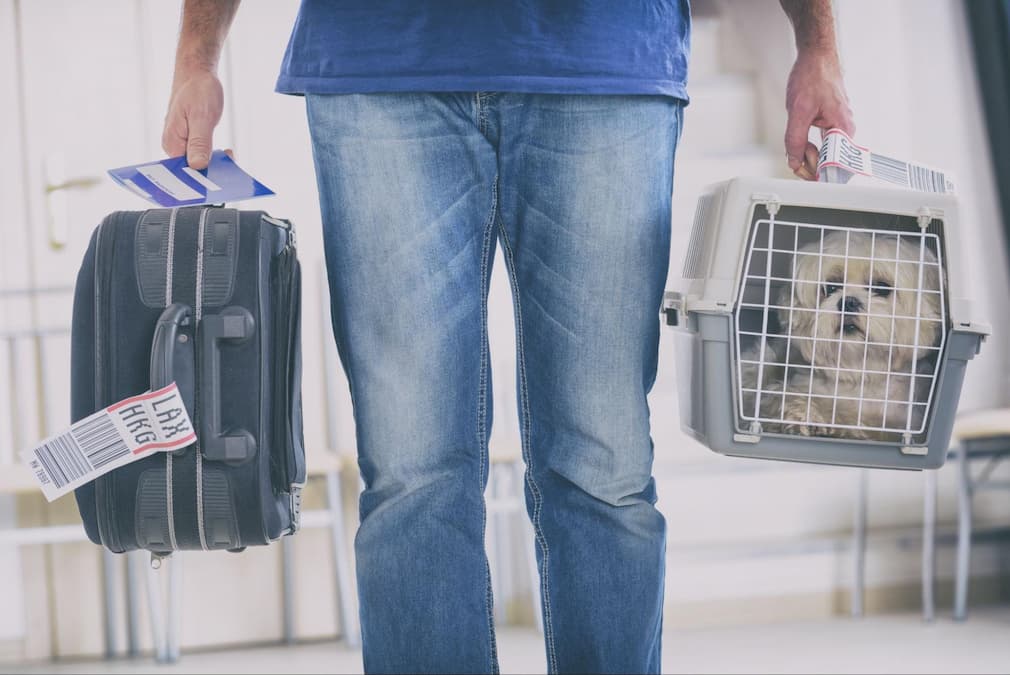Traveling is enjoyable when you can bring your dog along, but you will need to do some planning first. When it comes to travel, dogs are easy to deal with, but people are not because there are many rules and regulations regarding animals, in general, being transported to other countries.
Many of these issues will significantly depend on which country you are going to because they all have different requirements.

Preparing For the Trip
Planning a trip abroad brings many exciting opportunities but also plenty of stress when you decide to travel with your furry friend. Taking your pet overseas requires extra attention and preparation, from getting the necessary vaccinations to ensuring that your furry companion has the proper identification tags and documents.
Before you embark on an international adventure for two (or more), pet owners must do their due diligence.
Review the Customs Laws
You must know the requirements in the specific country you will be visiting because customs laws vary significantly by location. Unfortunately, some countries do not even allow foreign dogs to enter, and some of the ones that do may require a quarantine process of up to several months.
The quarantine will force you to be separated from your dog for quite some time, so be prepared if the country has that requirement. Traveling with more than one dog can also be challenging, so check to see if there is a limit to the number of pets you can bring. In general, most western countries will allow dogs, but you must prove that they have been given and are current on their rabies vaccination.
Give Your Dog a Checkup
If your dog has not already received all of their vaccinations, now would be a good time to do so because some countries will ask for its shot records. A quick visit to your veterinarian for a checkup is also an excellent way to discuss your concerns and ensure your dog is fit to travel.
Consider asking your veterinarian to write a note stating that your dog is in good health and has had all the appropriate vaccinations.
Consider Microchipping Your Dog
Microchipping your pet is a recommended part of traveling with your pet and may even be mandatory for international trips. It will help identify them and locate the owner if they are lost or run away during travel. Collars can provide this information but may come off or slip off in certain circumstances. Microchipping serves as a backup for identification so that you and your pet can be reunited in the event of separation.
Gather Necessary Documents and Supplies
Traveling internationally with your dog can be an exciting adventure, but you must take the time to acquire all of the necessary documents and supplies before departure. Such essential documents include health records, vaccination information, and travel certificates. You can also bring bedding, food supplies, a first-aid kit, and other comfort items for your furry friend on the journey. Taking the time to plan with the proper documentation and appropriate supplies can provide peace of mind and ensure your trip goes as smoothly as possible.
Quality Pet Carrier
A quality pet carrier provides a comfortable and secure environment for dogs while traveling. It can help reduce stress, as well as keep them safe in the event of an accident or emergency. With plenty of ventilation, support, and often built-in features such as water bottles, food holders, and pockets for treats and toys, pet carriers make traveling with your pup more manageable and enjoyable.
Seat Belt Tether
When you reach your destination, a car ride may be necessary. Keep your pup safe on the ride with a seat belt tether. A dog seat belt harness is like a regular leash harness, except the leash part is super short and connects to your car seatbelt.
Portable Food and Water Bowls
A portable dog food bowl is helpful for travel because it allows you to feed your pet meals on the go. Prevent your furry friend from feeling hungry and uncomfortable while on the go, and provide a sense of familiarity when visiting new places. Portable dog food bowls also typically come with lids to keep the food fresh and mess-free, so it is easy to transport from place to place.
Cleaning Wipes
No worries if your adventurous (or anxious) pet goes and gets dirty – waterless grooming wipes are the perfect solution when you don’t have access to a bath or running water. They’ll make quick work of wiping down your furry friend!
Medical Kit
Something to consider packing for your trip abroad is a first aid kit for your dog. A pet medical kit is designed to provide basic first-aid needs like splinter and tick removal, wound irrigation, cuts, and scrapes. How-to medical guides are also included. However, it is not designed for more severe injuries.

Find Pet-Friendly Travel Accommodations
Research Airline and Rental Car Policies
Finding the proper travel accommodations for your dog can also take time and effort. If you visit another country by car, you can ask if the car rental company allows pets. If you are traveling by plane, it will depend on the airline, when you are traveling, and which country you are going to.
Certain airlines do not accept pets, so your first objective is to find a pet-friendly airline.
Traveling with pet cargo in high temperatures can be risky, so some airlines will not accept them during the summer months. Also, check the airport requirements where you will arrive abroad because some airports in other countries do not allow pets, or they may require that you provide them with advance notice that you will be coming with a pet.
Obtain Pet-Friendly Living Accommodations
Once you have made it through customs, you must find living accommodations that accept pets. You will probably have your accommodations ready before you arrive, but make sure that you let the hotel, hostel, or apartment management know that you will have your dog with you.
Tips for Traveling in the Airport and On the Plane
Make Sure Your Dog Is Comfortable
As you go on your journey, consider the mental and physical comfort of your dog. Do your best to let your dog know that traveling will be safe, fun, and comfortable. Invest in a quality carrier for your dog because they may be there for a while. Please keep your dog calm when dealing with customs officials so they know your pet can handle the transition.
Tips For Adjusting to a New Environment
Dogs can be similar to humans when getting used to an unfamiliar space during travel. Before your trip, you can start training your pet for the changes that will come. If your furry friend is prone to fear and anxiety, you should start preparing them for travel far enough in advance to introduce things like new environments and their crate slowly.
Allow Time for Rest
Depending on where you are traveling, higher elevations can cause headaches. You won’t know if your dog has one, but you can tell when your pet isn’t feeling well. Allow time in your schedule for rest, and don’t push them to explore immediately. Please make sure you are with them during the transition.
Create a Comfortable Space
We suggest crate training your dog before you go on vacation. The crate will become a safe and comfortable space for them to retreat to when it comes time to rest or calm down.
Allow Time to Explore
When your furry friend is ready to sniff and check out the new environment, give them the space and freedom to do so on their terms. Reward with plenty of belly rubs and treats. Be proactive and look for objects or situations that might scare your pup and eliminate or avoid them.
Keep Your Routine
Just because you are on vacation that does not mean you should sacrifice your dog’s normal eating, sleeping, and walking routine. A regular schedule will help to ease anxiety in your pup.
Planning is critical when it comes to traveling with your pet. Everything depends on where you are going, so be sure to understand the customs laws before you arrive. Visit your veterinarian for a checkup and vaccinations, buy a nice carrier for your dog, and tell them what to expect before you leave. Have a safe and happy trip!
Have you ever traveled abroad with your dog? What was it like? Please share your experience with us in the comments.











